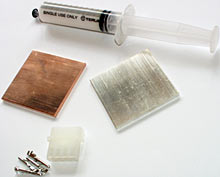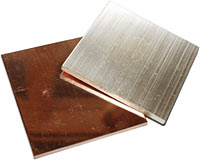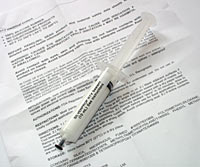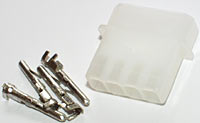
Silverprop overclocking accessories
Review date: 23 March 2001. Last modified 03-Dec-2011.
If you want to overclock with conviction, to make your CPU beg for mercy but not receive it, to come up with benchmark results that cause most people to become convinced that you're faking them, you need the right gear.
It's not just the CPU and motherboard; any schmuck can buy themselves a processor and an overclock-friendly mainboard. You need the fancy cooling hardware, and the connectors, and the other trimmings.
Local outfit Silverprop are setting themselves up as a one stop shop for this sort of stuff. They're not selling anything that Aussies wouldn't be able to get, one way or another, from other dealers here and overseas. But it's nice to be able to get it all in one place, and pay not-too-ridiculous prices.
The Silverprop gear I've seen so far doesn't have the home-made feel of similar products from other local dealers. OK, the items themselves are pretty basic, and there's not really a lot of room for innovation. But they come in nice heat-sealed logo-printed bags, the Web site looks tasteful, and you don't get that nasty feeling that you're dealing with one guy in a garage somewhere.
Silverprop tell me that when they get into their stride you'll be able to buy their gear from places like Cool PC, Below Zero and PC Cooling Australia; at the moment you can buy direct from them by various means, not including credit cards.
And now, the toys.
Cold plates
The purpose of a cold plate is to match a hot thing with a small contact surface - a modern Socket 370 or Socket A CPU - to a cool thing with a large contact surface - a heat sink or water block. You put a slab of conductive metal, generally copper, between the one and the other, and it serves as a heat spreader.
Cold plates are good with Peltier devices, too (see my article on Peltiers here). The white ceramic plates on either side of the ranks of semiconductor junctions in a Peltier device are highly thermally conductive, but a slab of copper in contact with the plate will still help a CPU to get heat into the Peltier.
Silverprop's cold plates are hefty items, 50 by 50 by 3mm in size and satisfyingly heavy. The copper one has some minor surface imperfections, but it's good and flat as standard and would be fine to use as is. The very enthusiastic can break out their sheet of plate glass and multiple grades of wet and dry paper and lap the plate down to an even flatter state, but I'd be surprised if it made a big difference.
For $AU10, the copper plate's an OK deal. Yes, metalworkers probably know a dozen places they could get one for less, but the price is on par for nice flat plates cut to size to suit CPU cooling. Some places try it on by charging $US10 for one of these.
The $AU18 "silver" cold plate is only silver plated copper. And thinly plated, at that; it's apparently got a five to ten micron silver layer all over it, which means its dimensions aren't significantly different from the copper plate, and also means that you can't lap it without practically instantly sanding off the silver.
The finish of the silver plate isn't as highly polished as the copper one. It looks like a square of plain aluminium plate. You could polish it up a bit without removing the plating, but it'd make no difference to the plate's behaviour, and the super-thin silver layer will also make no difference at all to the thermal behaviour of the plate. Silver is only about 6% better than copper in thermal conductivity anyway, so even if the plate were pure solid silver, it wouldn't work significantly better than a copper one.
Actually, because of the extreme softness of pure silver, it'd probably work worse, because it'd bend.
So if you want to have a bit of a pose and you've got some loopy setup that makes the cold plate visible to your admiring public, by all means drop the extra $AU8 on the silver plated plate. But the copper one's much the same thing, and it's easier to lap, if you want to.
Mmm... sticky...
Behold! Goop!
Or, to give it its technical name, Dow Corning neutral cure silicone RTV electrical sealant goop. Yours for $AU6.50 for a ten millilitre syringe.
RTV stands for Room-Temperature Vulcanising; it's a fancy way of saying you're talking about rubbery stuff that polymerises, going from liquid to solid, without anything special being done to it. Moisture in the air's all that's needed to cure this sort of sealant.
Silicone sealant like this isn't always the best choice for general caulking jobs - windows, fish-tanks, bathrooms. It's totally waterproof, but it costs more than other types of caulk, and it's not very resistant to mistreatment. It tears and abrades easily.
When you're sealing around a $500 CPU, though, you don't really care if you have to spend another buck on the sealant. And it's not a structural joint, or subject to abrasion; in fact, the crummy toughness of silicone is a good thing for overclocking purposes, because it makes it easier to remove the sealant when you want to change or fix something.
Slicing and peeling super-tough sealant off your precious motherboard is probably not going to be your idea of a good time, especially when it starts ripping components off the board.
Not that silicone's a lousy adhesive, mind you. If nothing mechanically attacks the silicone bead itself, it'll stick like billy-o. If it didn't, windows would be falling out of skyscrapers left and right.
The "neutral cure" part of the silicone's description's important too. This sort of sealant comes in an acid cure variant as well, which releases acetic acid (the stuff in vinegar that makes vinegar smell like vinegar) as it cures. Acid cure silicone's good for glazing applications, where the acid etches the glass a bit and helps the silicone to stick. But it attacks various soft metals, and is no good for use on circuit boards. Neutral cure silicones just release alcohol or a tiny amount of ammonia as they cure, and are safe for use on anything.
Get connected
Wow. A Molex plug. Be still, my beating heart.
Well, it's what computer technicians usually call a Molex plug, anyway. I had no luck finding one on the Molex product pages, though the shell and the crimp-on pins are easy enough to find elsewhere.
Whatever you call it, it's the kind of plug you need if you want to connect things like Peltiers and fans and pumps and such to your computer power supply, if you don't just splice some wires. It's surprisingly difficult to find these plugs in ordinary electronics shops - they've generally got the female connectors, as seen on the power supply's leads, but not the males. Silverprop are selling them for two Australian dollars.
Overall
I'll be doing a few water cooled Peltier-enhanced chronoton resonance matrix inversions in the near future, and the Silverprop cold plates and Peltiers and various flavours of goop are going to find a home in them. In the meantime, Aussie overclockers should be aware that these people give every appearance of having their act together.
Silverprop do combo deals as well. For instance, you can get an 80 watt Peltier device like the one I mention here, plus a tube of the sealant, a copper cold plate and a sachet of thermal grease, for $AU60.
Do try not to let the smoke out, kids.





